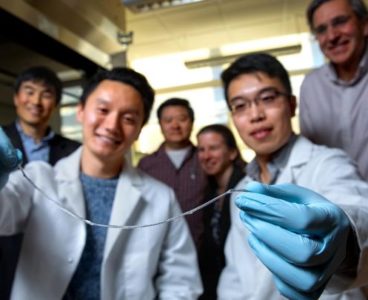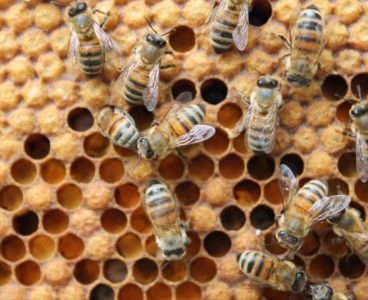
New Way to ‘See’ Objects Accelerates the Future of Self-Driving Cars
Tiny Particles Shift Back and Forth between Phases
Three years ago, when Richard Robinson, associate professor of materials science and engineering, was on sabbatical at Hebrew University in Israel, he asked a graduate student to send him some nanoparticles of a specific size. “When they got to me, I measured them with the spectrometer and I said, ‘Wait, you sent me the smaller…
Computer Program Aids Food Safety Experts With Pathogen Testing
An innovative computer program could be a big help for food safety professionals working to keep production facilities free of food-borne pathogens. Cornell University scientists have developed a computer program, Environmental Monitoring With an Agent-Based Model of Listeria (EnABLe), to simulate the most likely locations in a processing facility where the deadly food-borne pathogen Listeria…
Future of Planet-Cooling Tech: Study Creates Roadmap for Geoengineering Research
New Tool Uses Your Smartphone Camera to Track Your Alertness at Work
Cornell Releases New High-Yield Strawberry, Raspberry Varieties with Longer Lasting Flavor
These berries yield like the dickens. Cornell University’s berry breeding program is releasing two new varieties, which will be available for planting in spring 2019: a strawberry, Dickens, and a raspberry, Crimson Treasure. Both varieties produce large fruits with vibrant colors that maintain peak flavor for longer than most heritage varieties. The new berries are…
Just Add Sun: Cornell University Startup Converts Carbon Dioxide Into Fuel
Bioengineers Create Pathway to Personalized Medicine
Tiny Fern Holds Big Environmental Promise
A tiny fern – with each leaf the size of a gnat – may provide global impact for sinking atmospheric carbon dioxide, fixing nitrogen in agriculture and shooing pesky insects from crops. The fern’s full genome has been sequenced by a Cornell University and Boyce Thompson Institute (BTI) scientist and his colleagues around the world,…
Self-Assembling 3D Battery Would Charge in Seconds
A First for Quantum Physics: Electron Orbitals Manipulated in Diamonds
Algae-Forestry, Bioenergy Mix Could Help Make Carbon Dioxide Vanish From Thin Air
Breakthrough Made in Atomically Thin Magnets
Correcting Rare Crop Mutations Key to Improved Harvests
Physicists Build Muscle for Shape-Changing, Cell-Sized Robots
Spider’s Web Inspires Removable Implant that May Control Type 1 Diabetes
For the more than 1 million Americans who live with type 1 diabetes, daily insulin injections are literally a matter of life and death. And while there is no cure, a Cornell University-led research team has developed a device that could revolutionize management of the disease. In Type 1 diabetes, insulin-producing pancreatic cell clusters (islets)…
Engineers Program Tiny Robots to Move, Think Like Insects
While engineers have had success building tiny, insect-like robots, programming them to behave autonomously like real insects continues to present technical challenges. A group of Cornell University engineers has been experimenting with a new type of programming that mimics the way an insect’s brain works, which could soon have people wondering if that fly on…
Engineers Take Laser Pulses to New Dimensions
When you bang on a simple drumhead, it will most certainly make a noise, but you probably wouldn’t call that noise a musical note. “You hit it, and it generates all of these vibrations in random relationships to each other. As a result, you get a thud,” said Frank Wise, the Samuel B. Eckert Professor of…
Energy-Efficient Accelerator Was 50 Years in the Making
With the introduction of CBETA, the Cornell-Brookhaven ERL Test Accelerator, Cornell University and Brookhaven National Laboratory scientists are following up on the concept of energy-recovering particle accelerators first introduced by physicist Maury Tigner at Cornell more than 50 years ago. CBETA tests two energy-saving technologies for accelerators: energy recovery and permanent magnets. An energy recovery…
Bacteria-coated Nanofiber Electrodes Clean Pollutants in Wastewater
Cornell University materials scientists and bioelectrochemical engineers may have created an innovative, cost-competitive electrode material for cleaning pollutants in wastewater. The researchers created electro-spun carbon nanofiber electrodes and coated them with a conductive polymer, called PEDOT, to compete with carbon cloth electrodes available on the market. When the PEDOT coating is applied, an electrically active…
Bacteria-Coated Nanofiber Electrodes Digest Pollutants
Cornell materials scientists and bioelectrochemical engineers may have created an innovative, cost-competitive electrode material for cleaning pollutants in wastewater. The researchers created electro-spun carbon nanofiber electrodes and coated them with a conductive polymer, called PEDOT, to compete with carbon cloth electrodes available on the market. When the PEDOT coating is applied, an electrically active layer…
In a Cosmic Hit-and-Run, Icy Saturn Moon May Have Flipped
New Data Unearths Pesticide Peril in Beehives
Honeybees – employed to pollinate crops during the blooming season – encounter danger due to lingering and wandering pesticides, according to a new Cornell University study that analyzed the bee’s own food. Researchers used 120 pristine honeybee colonies that were placed near 30 apple orchards around New York state. After allowing the bees to forage…























